The Calf Muscle Group
Muscle Groups of the Lower Leg
Introduction
Introduction
The calf muscles rank among the body’s most important muscle groups, underpinning movement, balance, and stability. They play a crucial role in running, walking, jumping, pivoting, and maintaining overall steadiness. Owing to their intricate structure and multilayered function, a thorough understanding of each muscle’s role is essential not only for athletes and coaches but also for medical and physiotherapy professionals.
📌 In this document, following Gray’s Anatomy standards, we will conduct a precise, scientific review of the calf muscles. This analysis will cover a detailed classification of the muscles, their functions, innervation, blood supply, and their role in athletic movements and strengthening exercises. Our aim is to develop a deep understanding of the calf muscles’ structure and function so that, through informed and systematic training, we can prevent potential injuries and enhance athletic performance.
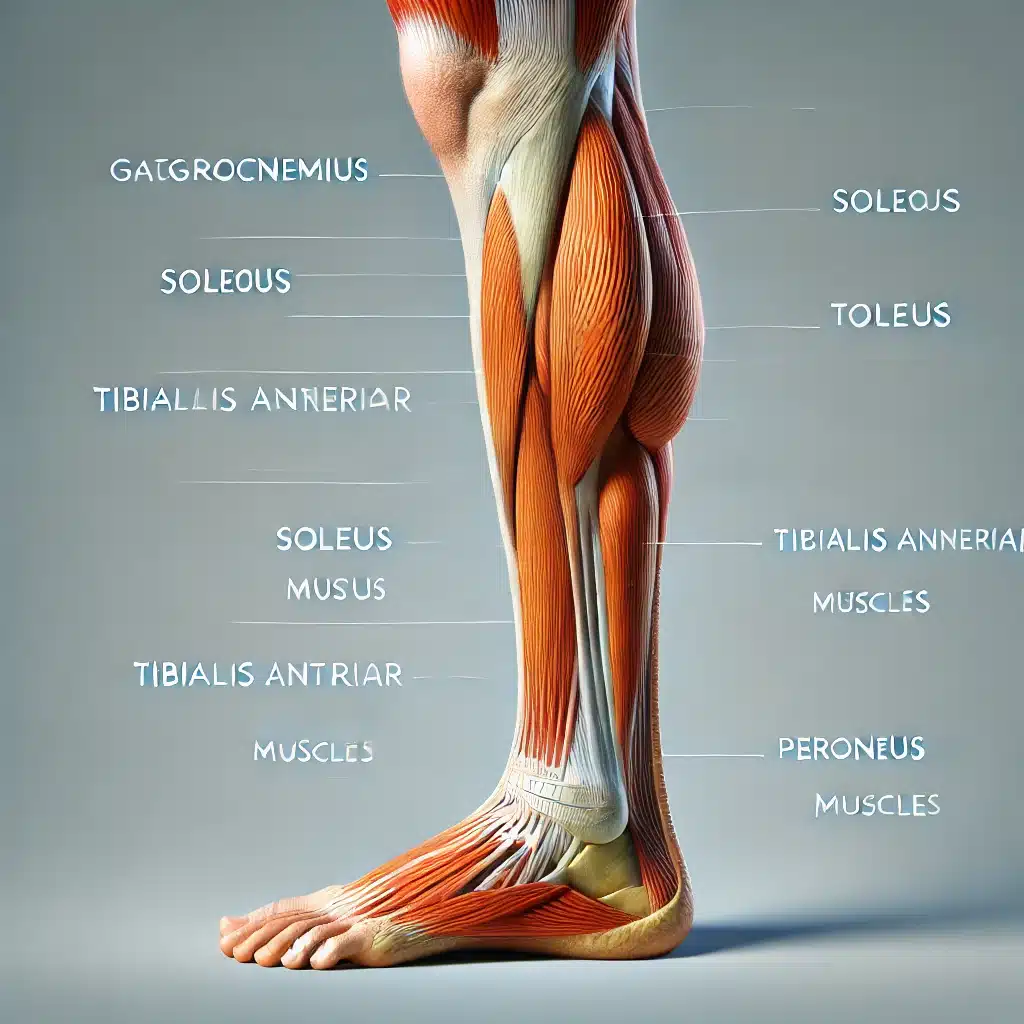
1. Anterior Muscles of the Lower Leg
Anterior Compartment
Tibialis Anterior Muscle
Tibialis Anterior Muscle
The tibialis anterior is one of the most important muscles in the anterior compartment of the lower leg, playing a key role in foot dorsiflexion and ankle stabilization. It keeps the toes from dragging on the ground while walking or running and is highly active in sports that demand quick, agile movements. Weakness of this muscle can lead to gait difficulties and foot drop. In the next section, we will conduct a comprehensive review of this muscle following the standard checklist. ✅
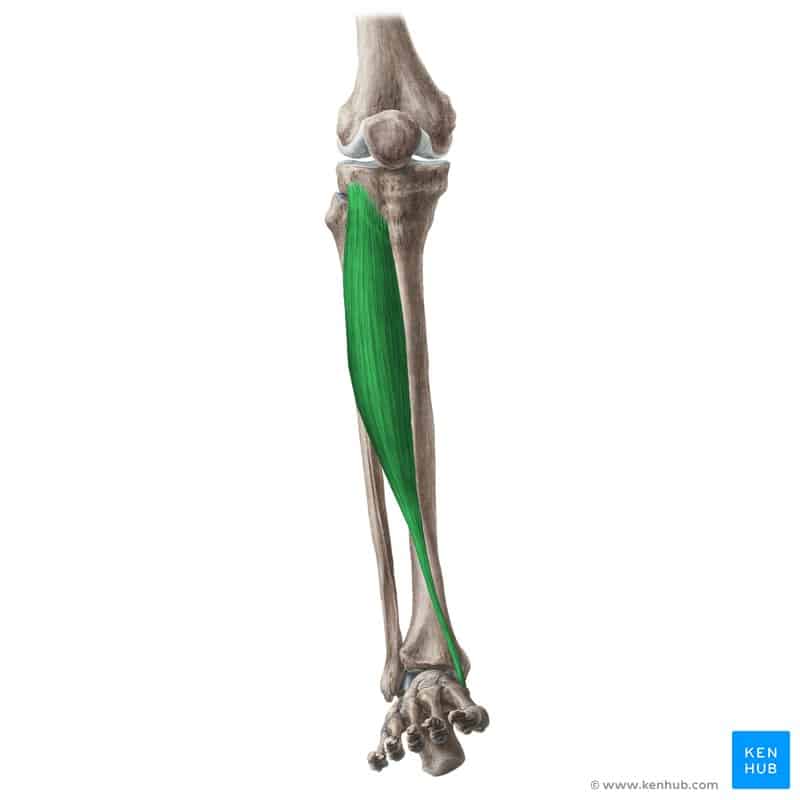
✅ Persian name: dorosht-ni ghodami
✅ Latin name: Tibialis Anterior
✅ Common name: front shin muscle
✅ Location:
🟡 Situated on the anterior aspect of the lower leg, originating from the tibia and inserting into the tarsal bones.
🟡 Part of the anterior compartment of the lower leg.
🟡 Responsible for dorsiflexing the foot and inverting the ankle.
✅ 🦾 Origin
✔ Lateral surface of the tibia
✔ Interosseous membrane of the leg
✅ 🦿 Insertion
✔ Medial cuneiform bone
✔ Base of the first metatarsal bone
✅ 📌 Function
✔ Ankle dorsiflexion – keeps the toes from dragging while walking
✔ Foot inversion – controls lateral foot movements
✔ Stabilizes the ankle during standing and walking
✅ 💪🏻 Muscle fiber type
✔ A combination of slow-twitch (Type I) fibers for endurance and fast-twitch (Type II) fibers for quick, powerful movements
✅ 🏋🏻♂️ Role in Motor and Athletic Performance
✔ Plays a crucial role in running, jumping, soccer, cycling, and rock climbing.
✔ Active during stretching movements and in maintaining balance on uneven terrain.
✅ 🧗🏻♂️ Muscle Strength and Endurance
✔ Plays a major role in ankle stability and preventing ankle sprains.
✔ Weakness of this muscle can lead to foot drop and increase the risk of falls.
🧠 Innervation
✔ Deep fibular (peroneal) nerve (L4, L5)
🩸 Blood supply
✔ Anterior tibial artery
✅ 🤼♂️ Role in Sports and Physical Activities
✔ Soccer and basketball: assists agility and foot-movement control
✔ Running and cycling: stabilizes the ankle during high-speed activities
✔ Yoga and Pilates: assists with controlled ankle and foot movements
✅ 🏌🏻♂️ Relationship with Other Muscles and Joints
✔ Interacts with the posterior tibialis and fibularis muscles to stabilize foot movements.
✔ Works with the ankle flexor muscles to maintain movement balance.
✅ 💉 Vulnerability and Potential Issues
✔ Anterior compartment syndrome — elevated pressure in the anterior compartment of the lower leg, leading to intense pain and muscle weakness.
✔ Tibialis anterior tendinitis — usually caused by long-distance running or overuse of the muscle.
✅ 🏋🏻♂️ Key exercises to strengthen the tibialis anterior
1️⃣ Dorsiflexion with a resistance band — reinforces ankle extensor movements.
2️⃣ Heel walks — enhances endurance and strengthens the muscle.
3️⃣ Wall shin raises — boosts power and control of ankle movements.
4️⃣ Incline walking — adds greater challenge for the tibialis anterior.
✅ 🧘🏻♀️ Stretching & Recovery
✔ Ankle pull-back stretch — reduces tension and enhances flexibility.
✔ Calf massage and foam rolling — helps prevent cramping and improves circulation.
✅ 🔍 Interesting fact
✔ This muscle is one of the key muscles involved in maintaining balance when standing on one leg!
✅ 💡 Practical tip
✔ To prevent weakness in this muscle, incorporate strengthening exercises into your training program.
🔴 Name & location: the anterior lower-leg muscle that runs from the tibia to the first metatarsal.
🟠 Anatomy: originates from the lateral surface of the tibia and inserts into the medial cuneiform and the first metatarsal.
🟡 Function: foot dorsiflexion, ankle inversion, and ankle stabilization while walking
🟢 Physiology: contains both slow- and fast-twitch fibers that support endurance and precise control of foot movements.
🔵 Innervation: deep fibular (peroneal) nerve (L4, L5)
🟣 Importance: active in running, jumping, soccer, cycling, and agile movements
🟤 Exercises: dorsiflexion with a resistance band, heel walks, and ankle control exercises.
⚫ Interesting fact: This muscle plays a significant role in maintaining balance on one leg.
Extensor Digitorum Longus Muscle
Extensor Digitorum Longus Muscle
The extensor digitorum longus is one of the anterior leg muscles whose primary duties are extending the second through fifth toes and dorsiflexing the foot. It plays a critical role in controlling toe movements during walking, running, and jumping, and weakness in this muscle can lead to an inability to lift the toes and to foot drop. In the following section, we will conduct a comprehensive review of this muscle using the standard checklist. ✅
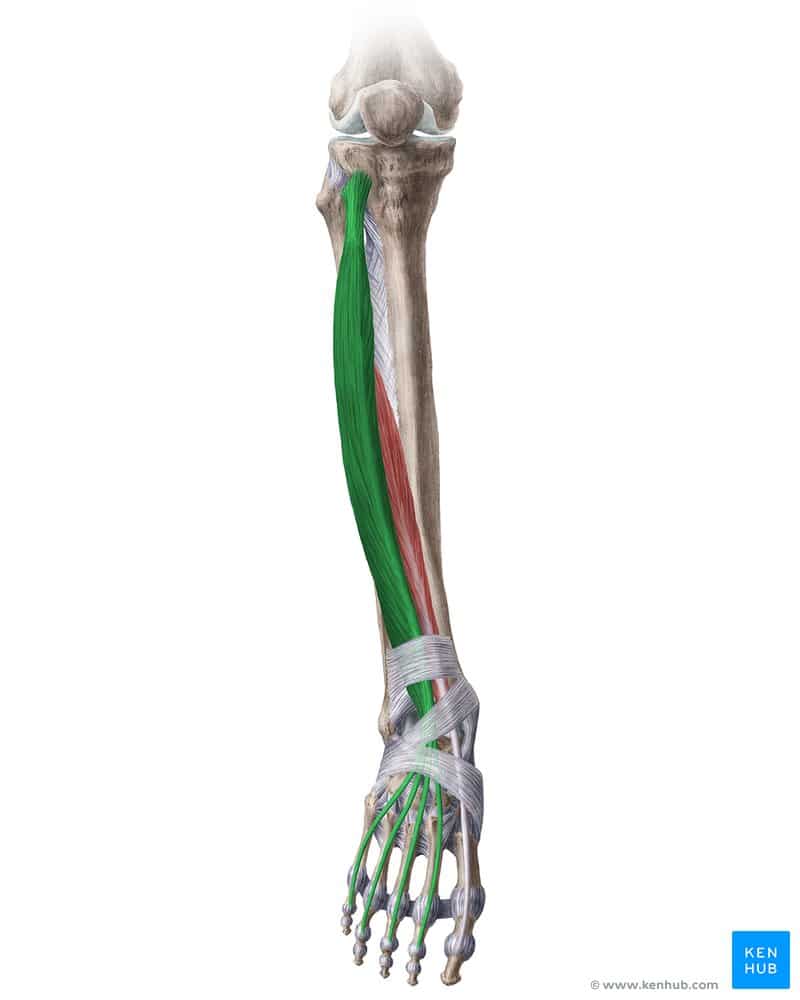
✅ Persian name: bazkonande-ye boland-e angoshtan-e pâ
✅ Latin name: Extensor Digitorum Longus
✅ Common name: “toe extensor muscle”
✅ Location:
🟡 Situated on the anterior side of the lower leg, originating from the tibia and fibula and attaching to the second through fifth toes.
🟡 Part of the anterior compartment of the lower leg.
🟡 Responsible for extending the toes and assisting in dorsiflexion of the foot.
✅ 🦾 Origin
✔ Anterior surface of the fibula
✔ Interosseous membrane of the leg
✅ 🦿 Insertion
✔ Middle and distal phalanges of toes 2–5
✅ 📌 Function
✔ Extension of toes 2–5 at the DIP and PIP joints
✔ Dorsiflexion of the ankle
✔ Stabilizes the toes when pushing off the ground (e.g., during running or jumping)
✅ 💪🏻 Muscle fiber type
✔ A combination of slow-twitch (Type I) fibers for endurance and fast-twitch (Type II) fibers for quick, powerful movements
✅ 🏋🏻♂️ Role in Motor and Athletic Performance
✔ Plays a key role in running, jumping, football, cycling, and any sport that demands a quick start.
✔ Active during stretching and fine foot-control movements, particularly in gymnastics and dance.
✅ 🧗🏻♂️ Muscle strength and endurance
✔ Plays an important role in stabilizing toe movements and preventing foot drop.
✔ Weakness in this muscle can reduce balance and increase the risk of ankle sprains.
🧠 Innervation
✔ Deep fibular (peroneal) nerve (L5, S1)
🩸 Blood supply
✔ Anterior tibial artery
✅ 🤼♂️ Role in Sports and Physical Activities
✔ Soccer and basketball: aids ball control and explosive starts
✔ Running and cycling: stabilizes toe movements upon ground contact.
✔ Yoga and Pilates: helps maintain balance and controlled ankle movements.
✅ 🏌🏻♂️ Relationship with Other Muscles and Joints
✔ Works in concert with the tibialis anterior and fibularis tertius to stabilize foot movements.
✔ Cooperates with the toe-flexor muscles to maintain balanced motion.
✅ 💉 Vulnerability and Potential Issues
✔ Extensor tendinitis — typically develops from overuse of this muscle in runners.
✔ Anterior compartment syndrome — elevated pressure on the local muscles and nerves.
✅ 🏋️♂️ Core exercises to strengthen the extensor digitorum longus
1️⃣ Toe extensions with a resistance band — builds toe-extensor strength.
2️⃣ Heel walks — enhances endurance and toe control.
3️⃣ Wall shin raises — strengthens the ankle and toe extensors.
4️⃣ Toe-off jumps — boosts lower-leg muscle endurance.
✅ 🧘🏻♀️ Stretching & Recovery
✔ Toe-down stretch — reduces tension and enhances flexibility.
✔ Foot and calf massage — helps prevent cramping and boosts circulation.
✅ 🔍 Interesting fact
✔ This muscle can also be active when lifting the foot off the gas pedal and during precise ankle control.
✅ 💡 Practical tip
✔ To prevent injuries in sports such as running and football, include strengthening and stretching exercises for this muscle in your training program.
🔴 Name & location: the anterior lower-leg muscle that runs from the fibula to the second through fifth toes.
🟠 Anatomy: originates from the lateral condyle of the tibia, the anterior surface of the fibula, and the interosseous membrane, inserting into the middle and distal phalanges of toes 2 – 5.
🟡 Function: toe extension, ankle dorsiflexion, and ankle stabilization during walking
🟢 Physiology: contains both slow- and fast-twitch fibers that support endurance and precise control of foot movements.
🔵 Innervation: deep fibular (peroneal) nerve (L5, S1)
🟣 Importance: active in running, jumping, soccer, cycling, and speed-based sports.
🟤 Exercises: toe extensions with a resistance band, heel walks, and plyometric jumps.
⚫ Interesting fact: This muscle is active in everyday movements such as climbing stairs and lifting the foot off the gas pedal, where it helps control precise ankle dorsiflexion.
Extensor Hallucis Longus Muscle
Extensor Hallucis Longus Muscle
The extensor hallucis longus muscle is one of the anterior compartment muscles of the lower leg whose primary function is to extend the hallux and assist in dorsiflexion of the foot. This muscle is critical for precise big-toe movements during running, jumping, and maintaining balance on one foot. Weakness in it can reduce hallux control, diminish explosive power in sudden leaps, and increase the risk of injury in sports such as soccer, track and field, and basketball. We will now provide a comprehensive examination of this muscle based on a standard checklist. ✅
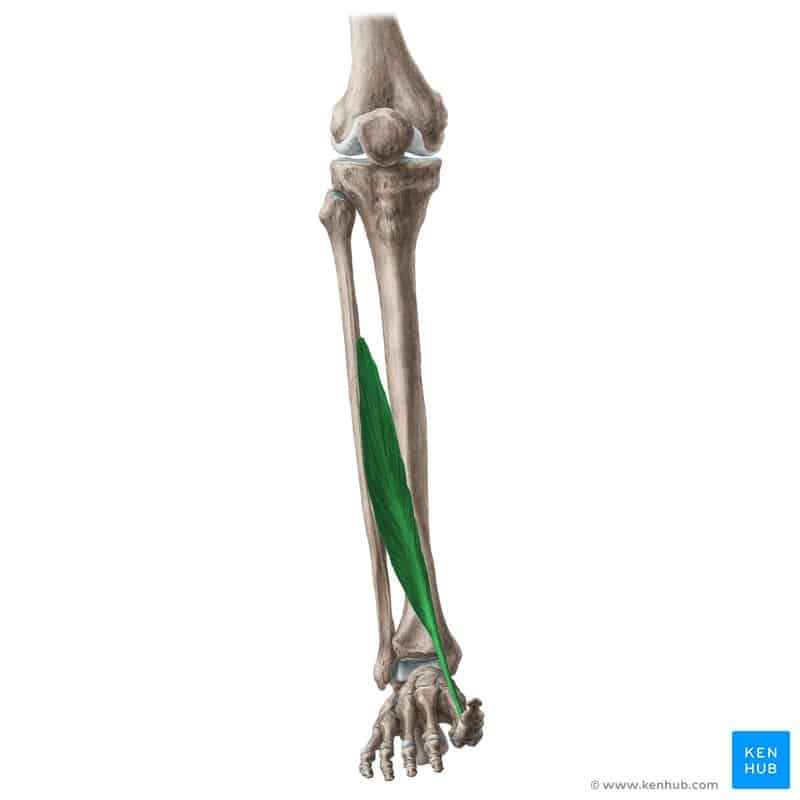
✅ Persian name: Bazkonande-ye Boland-e Shast-e Pā
✅ Latin name: Extensor Hallucis Longus
✅ Common name: “Big-toe extensor muscle”
✅ Location:
🟡 Situated in the anterior part of the lower leg, originating from the fibula and inserting into the big toe.
🟡 Classified within the anterior compartment muscles of the leg.
🟡 Responsible for extending the hallux joint and assisting foot dorsiflexion.
✅ 🦾 Origin
✔ Middle part of the fibula (anterior surface)
✔ Interosseous membrane of the leg
✅ 🦿 Insertion
✔ Base of the distal phalanx of the great toe (hallux)
✅ 📌 Function
✔ Extension of the hallux at the IP and MTP joints
✔ Dorsiflexion of the ankle
✔ Stabilization of the big toe during walking, running, and jumping
✅ 💪🏻 Muscle fiber type
✔ A combination of slow-twitch (Type I) fibers for endurance and fast-twitch (Type II) fibers for quick, powerful movements
✅ 🏋🏻♂️ Role in motor and athletic performance
✔ Plays a key role in sports such as soccer, basketball, track and field, and gymnastics that demand strong big-toe control.
✔ Active during explosive movements like sudden jumps and powerful kicks.
✅ 🧗🏻♂️ Muscle strength and endurance
✔ Plays an important role in stabilizing big-toe movements and generating power in agile actions.
✔ Weakness in this muscle can lead to poor toe control and reduced balance.
🧠 Innervation
✔ Deep fibular (peroneal) nerve (L5, S1)
🩸 Blood supply
✔ Anterior tibial artery
✅ 🤼♂️ Role in sports and physical activities
✔ Soccer and basketball: assists in ball control and rapid acceleration
✔ Running and jumping: stabilizes big-toe movements upon ground contact.
✔ Gymnastics and yoga: enhances flexibility and balance.
✅ 🏌🏻♂️ Relationship with other muscles and joints
✔ Works in conjunction with the extensor digitorum longus and tibialis anterior to stabilize foot movements.
✔ Cooperates with the flexor hallucis muscles to balance movement control.
✅ 💉 Vulnerability and potential problems
✔ Extensor hallucis longus tendinitis — pain on the top of the big toe that commonly occurs in runners.
✔ Increased pressure on the big-toe joint (hallux rigidus) — which reduces the range of motion of the great toe.
✅ 🏋🏻♂️ Core exercises to strengthen the extensor hallucis longus
1️⃣ Big-toe extensions with a resistance band — increases hallux extensor strength.
2️⃣ Seated toe lifts — enhances control of big-toe movements.
3️⃣ Wall shin raises — improves endurance and strengthens the ankle and big-toe extensors.
4️⃣ Single-leg balance on the toes — strengthens the hallux and boosts ankle stability.
✅ 🧘🏻♀️ Stretching and recovery exercises
✔ Backward big-toe stretch — reduces tension and increases flexibility.
✔ Foot and big-toe massage — helps prevent cramping and improves circulation.
✅ 🔍 Interesting fact
✔ This muscle becomes overactive even when walking on soft surfaces like sand to maintain balance!
✅ 💡 Practical Tip
✔ Strengthening exercises for this muscle can help improve shooting speed and accuracy in football!
🔴 Name and location: the extensor hallucis longus, an anterior lower-leg muscle extending from the fibula to the distal phalanx of the big toe.
🟠 Anatomy: originates from the middle surface of the fibula and inserts onto the distal phalanx of the big toe.
🟡 Function: extension of the big toe, dorsiflexion of the foot, and stabilization of the big toe during walking and running.
🟢 Physiology: Composed of both slow-twitch and fast-twitch muscle fibers to support endurance and precise control of thumb movements.
🔵 Innervation: deep fibular (peroneal) nerve (L5, S1)
🟣 Importance: plays a key role in football, track and field, gymnastics, and basketball.
🟤 Exercises: big-toe extension with a resistance band, single-leg balance, and strengthening the ankle dorsiflexors.
⚫ Interesting fact: this muscle is highly active when walking on sand.
Fibularis Tertius Muscle
Fibularis Tertius Muscle
The fibularis tertius muscle is one of the anterior lower-leg muscles that receives little attention but plays an important role in ankle stability and foot eversion. It acts as an accessory to the tibialis anterior and the extensor digitorum longus, contributing to foot dorsiflexion and ankle stabilization during walking and running. Weakness of this muscle can lead to ankle instability and an increased risk of sprains. Next, we will conduct a comprehensive review of this muscle according to the standard checklist. ✅
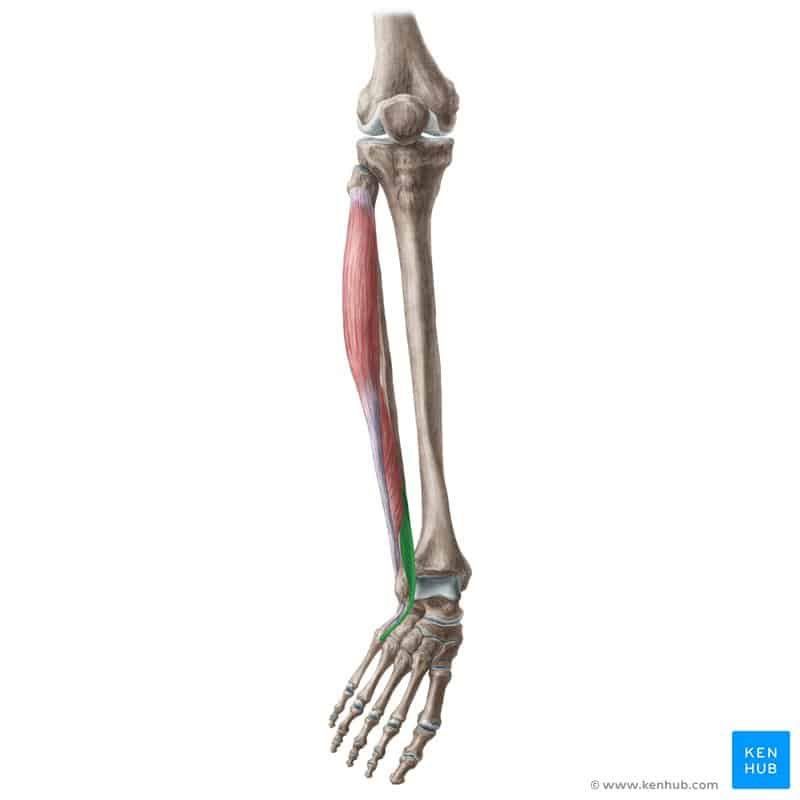
✅ Persian name: Fibularis Tertius (Nazok-ni-ye Sevvom)
✅ Latin name: Fibularis Tertius (Peroneus Tertius)
✅ Common name: “Small Fibularis”
✅ Location:
🟡 Situated in the anterior compartment of the lower leg, adjacent to the extensor digitorum longus.
🟡 Classified within the anterior compartment muscles of the leg.
🟡 Responsible for foot eversion and assisting in dorsiflexion.
✅ 🦾 Origin
✔ Distal anterior surface of fibula
✔ Interosseous membrane of leg
✅ 🦿 Insertion
✔ Base of the Fifth Metatarsal
✅ 📌 Function
✔ Dorsiflexion of the ankle – helps move the foot upward.
✔ Eversion of the foot – turns the sole of the foot outward.
✔ Stabilizes the ankle during walking and running.
✅ 💪🏻 Muscle Fiber Type
✔ A combination of slow-twitch (Type I) fibers for endurance and fast-twitch (Type II) fibers for rapid, powerful movements.
✅ 🏋🏻♂️ Role in Motor and Athletic Functions
✔ Plays a key role in running, jumping, and rapid directional changes in sports such as soccer and basketball.
✔ Engaged in stabilizing the foot when walking on uneven surfaces, especially during rock climbing and trail running.
✅ 🧗🏻♂️ Strength and Endurance
✔ Plays an important role in stabilizing foot movements and controlling lateral ankle motions.
✔ Weakness of this muscle can increase the risk of ankle sprains.
🧠 Innervation
✔ Deep fibular (peroneal) nerve (L5, S1)
🩸 Blood supply
✔ Anterior tibial artery
✅ 🤼♂️ Role in Sports and Physical Activities
✔ Soccer and basketball: assists in rapid pivoting and change of direction.
✔ Running and jumping: stabilizes ankle movements upon landing.
✔ Endurance sports: helps maintain balance and prevent ankle sprains.
✅ 🏌🏻♂️ Relationship with Other Muscles and Joints
✔ Interacts with the fibularis longus and brevis muscles to control lateral ankle movements.
✔ Collaborates with the tibialis anterior and extensor digitorum longus muscles to maintain movement balance.
✅ 💉 Vulnerability and Potential Issues
✔ Weakness or absence of the fibularis tertius muscle in some individuals can lead to decreased control of lateral foot movements.
✔ Recurrent ankle sprains – resulting from weakness in this muscle and insufficient stability of the ankle joint.
✅ 🏋🏻♂️ Main Exercises to Strengthen the Fibularis Tertius Muscle
1️⃣ Eversion with Resistance Band – strengthens lateral foot movements.
2️⃣ Edge Walking – improves lateral ankle control.
3️⃣ Single-Leg Balance Drills – increases muscle stability.
4️⃣ Weighted Dorsiflexion – strengthens the fibularis tertius alongside the tibialis anterior.
✅ 🧘🏻♀️ Stretching and Recovery
✔ Lateral calf stretches – reduce tension and increase flexibility.
✔ Ankle and foot massage – prevent cramping and improve circulation.
✅ 🔍 Fun Fact
✔ This muscle is present in about 85% of individuals, but in the remaining 15%, it is partially developed or absent! 😲
✅ 💡 Practical Tip
✔ Strengthening exercises for this muscle can help prevent recurrent ankle sprains.
🔴 Name and location: the anterior muscle of the lower leg that extends from the fibula to the fifth metatarsal.
🟠 Anatomy: Originates from the distal anterior surface of the fibula and inserts onto the fifth metatarsal.
🟡 Function: dorsiflexion of the ankle, eversion of the foot, and stabilization of the ankle during walking and running.
🟢 Physiology: contains both slow- and fast-twitch fibers that support endurance and precise control of foot movements.
🔵 Innervation: deep fibular (peroneal) nerve (L5, S1)
🟣 Importance: Active in soccer, basketball, running, jumping, and ankle stabilization.
🟤 Exercises: Eversion with resistance band, single-leg balance drills, edge walking.
⚫ Fun fact: It is naturally absent in about 15% of individuals.
2. Lateral muscles of the lower leg.
Lateral Compartment
Fibularis Longus Muscle.
Fibularis Longus - Peroneus Longus Muscle
The fibularis longus muscle is one of the lateral muscles of the lower leg, playing a key role in eversion of the foot and plantarflexion of the ankle. It supports the stability of the foot’s arch and is highly active in sports such as running, soccer, basketball, and lateral movements. Weakness of this muscle may lead to ankle instability and increase the likelihood of recurrent sprains. In the following, we will conduct a comprehensive review of this muscle according to the standard checklist. ✅
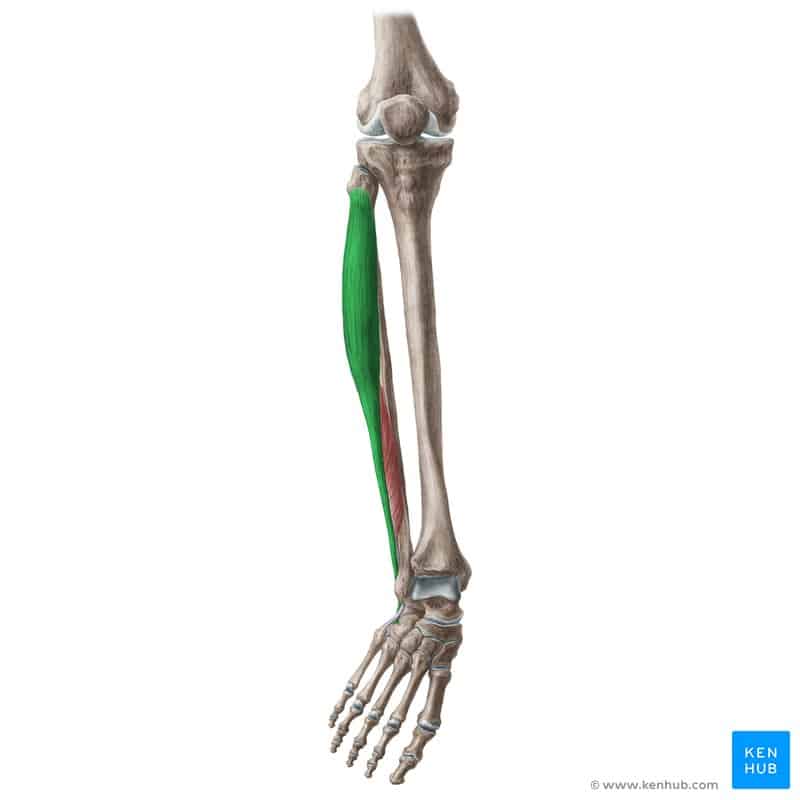
✅ Persian Name: Nâzkoni Boland
✅ Latin Name: Fibularis Longus (Peroneus Longus)
✅ Common Name: “Peroneus longus” or “lateral leg muscle”
✅ Location:
🟡 Located on the lateral side of the lower leg, originating from the fibula and extending beneath the sole of the foot.
🟡 Part of the lateral compartment of the lower leg muscles.
🟡 Responsible for eversion of the foot and assisting in plantarflexion of the ankle.
✅ 🦾 Origin
✔ Upper lateral surface of the fibula
✔ Head of the fibula
✅ 🦿 Insertion
✔ Medial cuneiform bone (under the foot)
✔ Base of the first metatarsal bone (under the foot)
✅ 📌 Function
✔ Eversion of the foot – helps stabilize the foot on the ground.
✔ Plantarflexion of the ankle – lowers the foot when standing on the toes.
✔ Arch support – prevents collapse of the foot arch.
✅ 💪🏻 Muscle Fiber Type
✔ A combination of slow-twitch (Type I) fibers for endurance and fast-twitch (Type II) fibers for rapid, powerful movements.
✅ 🏋🏻♂️ Role in Motor and Athletic Functions
✔ Active in sports such as soccer, basketball, running, skiing, and tennis that involve frequent lateral movements.
✔ Assists in stability when walking on uneven terrain, such as mountain hiking and trail running.
✅ 🧗🏻♂️ Strength and Endurance
✔ Plays an important role in preventing ankle sprains.
✔ Weakness of this muscle may lead to decreased ankle control and increased risk of injury in sports involving frequent lateral movements.
🧠 Innervation
✔ Superficial fibular nerve (L5, S1, S2)
🩸 Blood Supply
✔ Fibular artery
✅ 🤼♂️ Role in Sports and Physical Activities
✔ Soccer and basketball: controls lateral movements and rapid directional changes.
✔ Running and jumping: stabilizes the ankle during changes in ground level.
✔ Aquatic sports such as swimming and surfing: controls the foot during kicking movements.
✅ 🏌🏻♂️ Relationship with Other Muscles and Joints
✔ Interacts with the fibularis brevis and tibialis anterior muscles to stabilize lateral foot movements.
✔ Collaborates with the ankle plantarflexor muscles to balance control of ankle motions.
✅ 💉 Vulnerability and Potential Issues
✔ Peroneal tendinitis – causing pain on the lateral side of the ankle.
✔ Increased risk of recurrent ankle sprains due to weakened lateral ankle control.
✅ 🏋🏻♂️ Main Exercises for Strengthening the Fibularis Longus
1️⃣ Eversion with Resistance Band – strengthens lateral foot movements.
2️⃣ Edge Walking – improves lateral ankle control.
3️⃣ Incline Heel Raises – increases strength of the lateral ankle muscles.
4️⃣ Single-Leg Lateral Hops – enhances agility and lateral control.
✅ 🧘🏻♀️ Stretching and Recovery
✔ Lateral calf stretches – reduce tension and increase flexibility.
✔ Ankle and foot massage – prevent cramping and improve circulation.
✅ 🔍 Fun Fact
✔ The tendon of this muscle passes beneath the sole of the foot and acts on the first metatarsal and medial cuneiform bones.
✅ 💡 Practical Tip
✔ Strengthening this muscle can improve balance and reduce common injuries in high-impact sports such as soccer and basketball.
🔴 Name and location: the lateral muscle of the lower leg that extends from the fibula to the sole of the foot.
🟠 Anatomy: Originates from the lateral surface of the fibula and inserts onto the first metatarsal and medial cuneiform.
🟡 Function: Eversion of the foot, plantarflexion of the ankle, and arch support.
🟢 Physiology: comprised of slow-twitch and fast-twitch fibers for endurance and lateral movement control.
🔵 Innervation: Superficial fibular nerve (L5, S1, S2)
🟣 Importance: Active in soccer, basketball, running, mountaineering, and surfing.
🟤 Exercises: Eversion with resistance band, single-leg lateral hops, edge walking.
⚫ Fun fact: The tendon of this muscle runs beneath the sole of the foot and impacts the foot’s arch.
Fibularis Brevis Muscle.
Fibularis Brevis - Peroneus Brevis Muscle
The fibularis brevis muscle is one of the lateral compartment muscles of the lower leg, whose primary functions are eversion of the foot and assisting with ankle plantarflexion. It works alongside the fibularis longus and plays a key role in ankle stability, preventing lateral sprains, and supporting side-to-side movements in high-impact sports such as soccer and basketball. Weakness of this muscle leads to decreased ankle control and an increased risk of recurrent sprains. Below, we will conduct a comprehensive review of this muscle according to the standard checklist. ✅
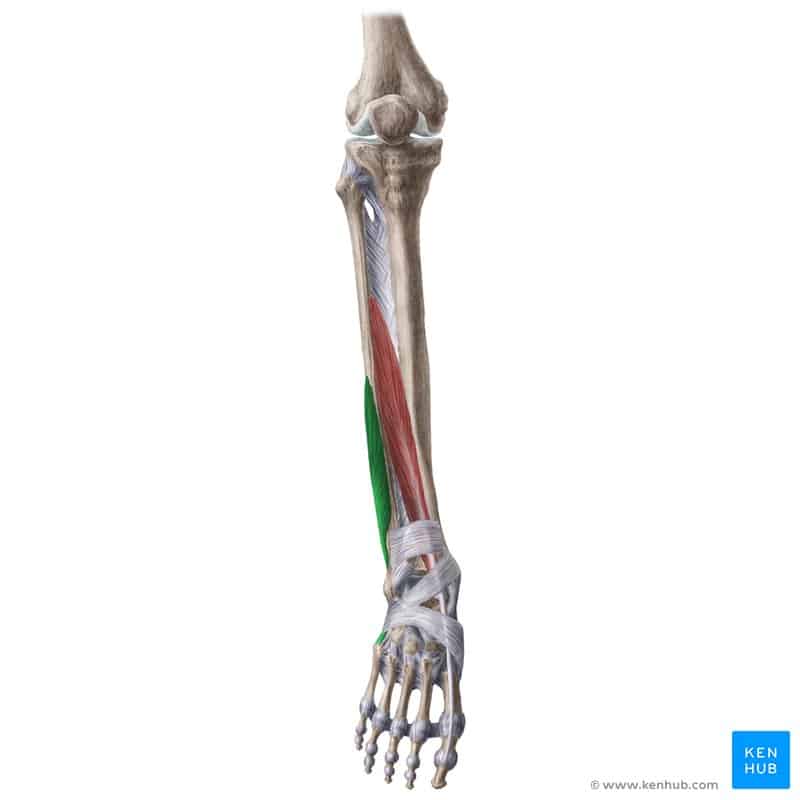
✅ Persian Name: Nâzkoni Kutāh
✅ Latin Name: Fibularis Brevis (Peroneus Brevis)
✅ Common Name: “Peroneus brevis” or “short lateral leg muscle”
✅ Location:
🟡 On the lateral side of the lower leg, beneath the fibularis longus.
🟡 Part of the lateral compartment of the lower leg muscles.
🟡 Responsible for eversion of the foot and assisting in plantarflexion of the ankle.
✅ 🦾 Origin
✔ Lower two-thirds of the lateral surface of the fibula.
✅ 🦿 Insertion
✔ Base of the fifth metatarsal bone.
✅ 📌 Function
✔ Eversion of the foot – helps maintain balance and prevent sprains.
✔ Plantarflexion of the ankle – assists in lowering the foot when standing on the toes.
✔ Stabilizes the ankle during rapid changes in direction.
✅ 💪🏻 Muscle fiber type
✔ A combination of slow-twitch (Type I) fibers for endurance and fast-twitch (Type II) fibers for quick, powerful movements
✅ 🏋🏻♂️ Role in Motor and Athletic Functions
✔ Active in sports such as soccer, basketball, running, tennis, and mountaineering.
✔ Aids stability and balance when walking on inclined and uneven surfaces.
✅ 🧗🏻♂️ Strength and Endurance
✔ Plays a key role in preventing lateral ankle sprains.
✔ Weakness of this muscle can lead to reduced lateral foot control and an increased risk of injury in agility and endurance sports.
🧠 Innervation
✔ Superficial fibular nerve (L5, S1, S2)
🩸 Blood Supply
✔ Fibular artery
✅ 🤼♂️ Role in Sports and Physical Activities
✔ Soccer and basketball: controls lateral movements and prevents ankle sprains.
✔ Running and rapid changes of direction – helps maintain balance and foot stability during sudden direction shifts.
✔ Endurance sports such as mountaineering: helps maintain balance on unstable terrain.
✅ 🏌🏻♂️ Relationship with Other Muscles and Joints
✔ Interacts with the fibularis longus and tibialis anterior muscles to control lateral foot movements.
✔ Collaborates with the ankle plantarflexor muscles to balance ankle motion.
✅ 💉 Vulnerability and Potential Issues
✔ Peroneal tendinitis – pain on the lateral side of the ankle.
✔ Increased risk of ankle sprains due to weakened lateral ankle control.
✅ 🏋🏻♂️ Main Exercises for Strengthening the Fibularis Brevis
1️⃣ Eversion with Resistance Band – increases lateral foot strength.
2️⃣ Single-Leg Balance with Ankle Rotation – improves ankle control and balance.
3️⃣ Edge Walking – strengthens the lateral ankle muscles.
4️⃣ Single-Leg Lateral Hops – enhances agility and ankle stability.
✅ 🧘🏻♀️ Stretching and Recovery
✔ Lateral calf stretches – reduce tension and increase flexibility.
✔ Ankle and foot massage – prevent cramping and improve circulation.
✅ 🔍 Fun Fact
✔ In some individuals, this muscle is partially fused with the fibularis longus and lacks an independent structure.
✅ 💡 Practical Tip
✔ Strengthening this muscle is crucial for runners and athletes in sports like soccer and basketball to prevent recurrent ankle sprains.
🔴 Name and Location: Lateral muscle of the lower leg extending from the fibula to the fifth metatarsal.
🟠 Anatomy: Originates from the lateral surface of the fibula, inserting onto the fifth metatarsal.
🟡 Function: Foot eversion, ankle plantarflexion, and lateral stabilization of the ankle.
🟢 Physiology: comprised of slow-twitch and fast-twitch fibers for endurance and lateral movement control.
🔵 Innervation: Superficial fibular nerve (L5, S1, S2)
🟣 Importance: Active during football, basketball, running, climbing, and balance-focused sports.
🟤 Exercises: Foot eversion with a resistance band, single-leg balance, and lateral hopping drills.
⚫ Interesting Note: In some individuals, it may partially merge with the fibularis longus.
3. Posterior muscles of the lower leg
Posterior Compartment
Superficial posterior muscles
Superficial Layer
Gastrocnemius Muscle
Gastrocnemius Muscle
The gastrocnemius muscle, also known as the calf muscle, is one of the superficial posterior muscles of the lower leg. It is the largest and most visible muscle of the calf, forming the prominent bulge at the back of the lower leg when contracted. Its primary function is plantarflexion of the ankle (pointing the foot downward) and assisting in knee flexion. This muscle plays a crucial role in running, jumping, walking, and explosive movements. Weakness of the gastrocnemius can lead to reduced explosive power in athletic activities and instability of the ankle and knee. Below, we will provide a comprehensive review of this muscle according to the standard checklist. ✅

✅ Persian Name: Doqoloo
✅ Latin Name: Gastrocnemius
✅ Common Name: “Calf muscle” or “back calf muscle”
✅ Location:
🟡 Located at the back of the lower leg, originating from the femur and attaching to the Achilles tendon.
🟡 Part of the superficial posterior compartment of the lower leg muscles.
🟡 Responsible for plantarflexion of the ankle and assisting in knee flexion.
✅ 🦾 Origin
✔ Medial head: Posterior surface of the medial condyle of the femur
✔ Lateral head: Posterior surface of the lateral condyle of the femur
✅ 🦿 Insertion
✔ Achilles tendon, which attaches to the heel bone (calcaneus).
✅ 📌 Function
✔ Plantarflexion of the ankle – assists in walking, running, and jumping.
✔ Assists in knee flexion – important for jumping movements and quick starts.
✔ Generates explosive power in lower-body movements.
✅ 💪🏻 Muscle Fiber Type
✔ A combination of fast-twitch fibers (Type II) for power and speed in explosive movements.
✅ 🏋🏻♂️ Role in Motor and Athletic Performance
✔ Active in sports such as running, long and high jump, weightlifting, basketball, and football.
✔ Contributes to explosive movements like quick starts and sudden changes of direction.
✅ 🧗🏻♂️ Muscle Strength and Endurance
✔ Plays an important role in calf muscle strength and endurance, helping to prevent injuries caused by sudden stress.
✔ Weakness in this muscle can lead to decreased athletic performance and instability of the knee and ankle.
🧠 Innervation
✔ Tibial nerve (S1, S2)
🩸 Blood Supply
✔ Posterior tibial artery
✅ 🤼♂️ Role in Sports and Physical Activities
✔ Football and basketball: Enhances jumping power and acceleration.
✔ Running and jumping: Generates the necessary force for explosive movements.
✔ Bodybuilding and weightlifting: Maintains balance during movements like squats and deadlifts.
✅ 🏌🏻♂️ Relationship with Other Muscles and Joints
✔ Works in conjunction with the soleus muscle and toe flexors to control ankle movements.
✔ Cooperates with the hamstrings and quadriceps to enhance knee stability and generate powerful movements.
✅ 💉 Vulnerability and Potential Issues
✔ Calf muscle cramps and spasms – usually occur due to dehydration or overuse.
✔ Achilles tendinitis – caused by excessive stretching of the muscle.
✅ 🏋🏻♂️ Key Exercises to Strengthen the Gastrocnemius
1️⃣ Calf raises – increase muscle strength and size.
2️⃣ Vertical jumps – boost explosive power.
3️⃣ Box jumps – improve jumping ability and quick starts.
4️⃣ Hill sprints – enhance muscular endurance.
✅ 🧘🏻♀️ Stretching and Recovery
✔ Wall calf stretch – prevents cramps and improves flexibility.
✔ Massage of the Achilles tendon and calf muscles – enhances blood circulation and reduces muscle fatigue.
✅ 🔍 Interesting Fact
✔ This muscle is one of the most important for jumping, and it is highly developed in athletes who specialize in jumping sports, such as basketball players!
✅ 💡 Practical Tip
✔ To prevent injury, it is essential to warm up before exercise and perform stretching exercises for this muscle.
🔴 Name and Location: A superficial muscle at the back of the lower leg, extending from the femur to the Achilles tendon.
🟠 Anatomy: Originates from the femoral condyles, inserts into the Achilles tendon and the heel bone.
🟡 Function: Plantarflexes the ankle, assists in knee flexion, generates explosive power.
🟢 Physiology: Contains fast-twitch fibers for quick and powerful movements.
🔵 Innervation: Tibial nerve (S1, S2).
🟣 Importance: Active in running, jumping, football, basketball, and weightlifting.
🟤 Exercises: Calf raises, vertical jumps, speed drills.
⚫ Interesting Note: A key muscle for high jumps and powerful leg movements.
Soleus Muscle
Soleus Muscle
The soleus muscle is one of the posterior muscles of the lower leg, located beneath the gastrocnemius (calf) muscle. Compared to the gastrocnemius, it is larger in volume but less visible. Its primary function is plantarflexion of the ankle and maintaining stability while standing. Unlike the gastrocnemius, the soleus does not assist in knee flexion, as it does not originate from the femur. It plays a key role in activities such as running, long-distance walking, and muscular endurance. Weakness in this muscle can lead to reduced leg endurance, instability while standing, and an increased risk of muscle cramps during endurance activities. Below, we will provide a comprehensive review of this muscle according to the standard checklist. ✅

✅ Persian Name: Na‘li
✅ Latin Name: Soleus
✅ Common Name: “Deep calf muscle” or “endurance muscle of the calf”
✅ Location:
🟡 Located at the back of the lower leg, beneath the gastrocnemius muscle.
🟡 Part of the superficial posterior compartment of the lower leg muscles.
🟡 Responsible for plantarflexion of the ankle and maintaining balance while standing.
✅ 🦾 Origin
✔ Proximal tibia and fibula (posterior surface)
✔ Interosseous membrane of the leg
✅ 🦿 Insertion
✔ Achilles tendon, which attaches to the heel bone (calcaneus).
✅ 📌 Function
✔ Plantarflexion of the ankle – the most important muscle for walking and postural endurance.
✔ Maintains body balance while standing and during slow movements.
✔ Generates the necessary force for long-distance running and endurance activities.
✅ 💪🏻 Muscle Fiber Type
✔ Composed mostly of slow-twitch fibers (Type I), making it well-suited for high endurance and prolonged activities.
✅ 🏋🏻♂️ Role in Motor and Athletic Performance
✔ Active in endurance sports such as long-distance running, walking, and cycling.
✔ Helps maintain balance when standing on one leg.
✔ Plays an important role in controlling slow movements, such as in yoga and tai chi.
✅ 🧗🏻♂️ Muscle Strength and Endurance
✔ The soleus muscle has the greatest role in maintaining balance and lower-body endurance.
✔ Weakness in this muscle leads to early fatigue during endurance sports and reduced body stability.
🧠 Innervation
✔ Tibial nerve (S1, S2)
🩸 Blood Supply
✔ Posterior tibial artery
✅ 🤼♂️ Role in Sports and Physical Activities
✔ Long-distance running and walking: Improves endurance and reduces leg fatigue.
✔ Cycling: Helps transfer force to the pedal.
✔ Squats and weightlifting: Maintains balance during heavy movements.
✅ 🏌🏻♂️ Relationship with Other Muscles and Joints
✔ Works together with the gastrocnemius and toe flexors to control ankle movements.
✔ Cooperates with the quadriceps and hamstrings to provide knee stability.
✅ 💉 Vulnerability and Potential Issues
✔ Achilles tendinitis – due to excessive strain on the tendon.
✔ Muscle cramps caused by overexertion – common in endurance runners.
✅ 🏋🏻♂️ Key Exercises to Strengthen the Soleus
1️⃣ Seated calf raises – target the soleus more effectively.
2️⃣ Toe walking – increases muscle endurance.
3️⃣ Long-distance running – enhances soleus endurance.
4️⃣ Step downs – improve balance and muscle control.
✅ 🧘🏻♀️ Stretching and Recovery
✔ Bent knee calf stretch – provides a deeper stretch for the soleus muscle.
✔ Massage of the Achilles tendon and calf muscles – helps prevent fatigue and muscle cramps.
✅ 🔍 Interesting Fact
✔ The soleus muscle is one of the most important muscles for maintaining body balance during prolonged standing!
✅ 💡 Practical Tip
✔ Endurance runners and athletes who spend long periods on their feet should strengthen this muscle to prevent early fatigue.
🔴 Name and Location: A superficial muscle at the back of the lower leg, located beneath the gastrocnemius.
🟠 Anatomy: Originates from the tibia and fibula, inserts into the Achilles tendon.
🟡 Function: Plantarflexes the ankle, stabilizes balance during prolonged standing and walking.
🟢 Physiology: Contains slow-twitch fibers for high endurance.
🔵 Innervation: Tibial nerve (S1, S2).
🟣 Importance: Active in running, walking, cycling, and weightlifting.
🟤 Exercises: Seated calf raises, toe walking, endurance running.
⚫ Interesting Note: A key muscle for maintaining balance during long periods of standing.
Plantaris Muscle
Plantaris Muscle
The plantaris muscle is a small, long muscle located at the back of the lower leg, and in some people, it is completely absent! 🤯 This muscle is missing in about 10–40% of individuals, and in those who have it, it plays a minor role in plantarflexion of the ankle and assisting with knee flexion. Due to its small size, some anatomists believe that the plantaris is a vestigial muscle from our evolutionary past and does not have a specific function. However, in certain sports and physical activities, this muscle can help maintain balance and stability in the ankle and knee. Below, we will provide a comprehensive review of this muscle according to the standard checklist. ✅
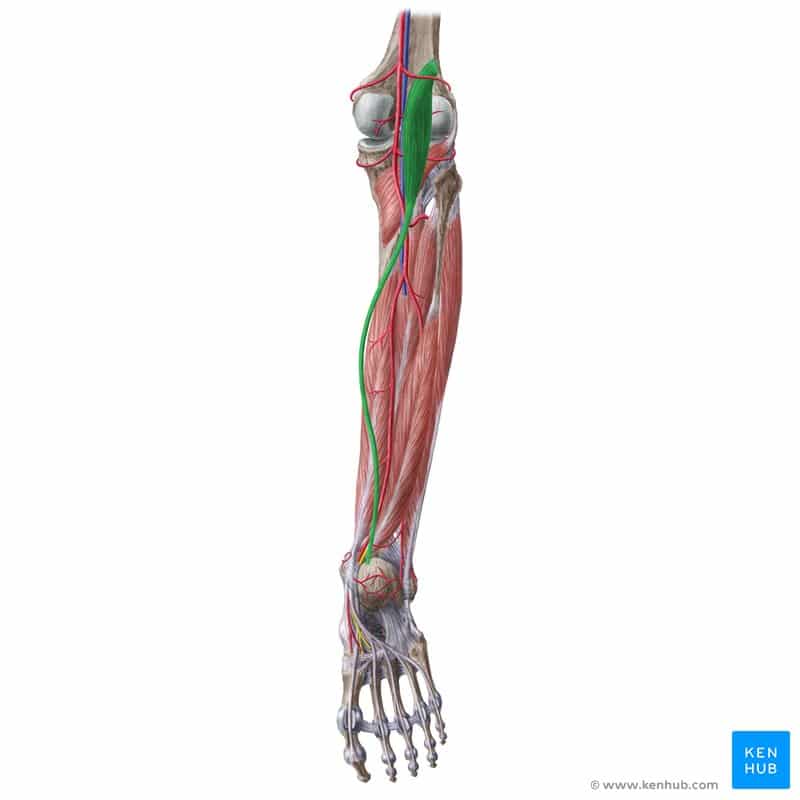
✅ Persian Name: Plantaris
✅ Latin Name: Plantaris
✅ Common Name: “Small calf muscle” or “miniature calf muscle”
✅ Location:
🟡 Located at the back of the lower leg, next to the gastrocnemius, with a very long and thin tendon.
🟡 Part of the superficial posterior compartment of the lower leg muscles.
🟡 Assists in plantarflexion of the ankle and knee flexion, but its impact is minimal.
✅ 🦾 Origin
✔ Lateral supracondylar ridge of the femur
✅ 🦿 Insertion
✔ Achilles tendon (or directly to the calcaneus bone)
✅ 📌 Function
✔ Assists in plantarflexion of the ankle – but its effect is very minimal.
✔ Assists in knee flexion – slightly, together with the gastrocnemius.
✔ Provides minor stabilizing function for the knee and ankle joints.
✅ 💪🏻 Muscle Fiber Type
✔ A combination of slow-twitch (Type I) and fast-twitch (Type II) fibers, but its activity is very low.
✅ 🏋🏻♂️ Role in Motor and Athletic Performance
✔ Has virtually no significant impact on motor performance and is generally negligible in professional sports.
✔ Its tendon is sometimes used for Achilles tendon reconstruction surgery.
✅ 🧗🏻♂️ Muscle Strength and Endurance
✔ This muscle does not play a major role in generating strength and is considered an accessory muscle.
✔ The absence of this muscle in some individuals has no negative effect on motor performance.
🧠 Innervation
✔ Tibial nerve (S1, S2)
🩸 Blood Supply
✔ Posterior tibial artery
✅ 🤼♂️ Role in Sports and Physical Activities
✔ Has little role in endurance and strength sports.
✔ Sometimes has a minor effect on knee and ankle stability.
✅ 🏌🏻♂️ Relationship with Other Muscles and Joints
✔ Works together with the gastrocnemius and soleus to control ankle movements.
✔ Slightly cooperates with the knee flexor muscles to help stabilize the knee.
✅ 💉 Vulnerability and Potential Issues
✔ Plantaris rupture – seen in some athletes, but generally not clinically significant.
✔ Pain from this muscle is sometimes mistaken for Achilles tendon rupture.
✅ 🏋🏻♂️ Key Exercises to Strengthen the Plantaris Muscle
1️⃣ Calf raises – involve this muscle to a small extent.
2️⃣ Seated calf press – helps partially activate the muscle.
3️⃣ Stretching exercises to improve flexibility (calf stretching).
✅ 🧘🏻♀️ Stretching and Recovery
✔ Calf stretches, especially against a wall – help maintain muscle flexibility.
✔ Calf massage – improves blood circulation and reduces muscle tension.
✅ 🔍 Interesting Fact
✔ This muscle is naturally absent in 10 to 40 percent of people! 😲
✅ 💡 Practical Tip
✔ This muscle is known as a “useless muscle,” and its absence has no effect on motor performance.
🔴 Name and Location: A superficial muscle at the back of the lower leg, located next to the gastrocnemius.
🟠 Anatomy: Originates from the lateral condyle of the femur, inserting into the Achilles tendon or directly into the heel bone (calcaneus).
🟡 Function: Assists in plantarflexion of the ankle and knee flexion, but its effect is minimal.
🟢 Physiology: Contains a mix of slow-twitch and fast-twitch fibers, but its activity is low.
🔵 Innervation: Tibial nerve (S1, S2).
🟣 Importance: Has no significant effect on athletic performance, but may provide a supportive role in some individuals.
🟤 Exercises: Calf raises, resisted knee flexion exercises, and calf stretching.
⚫ Interesting Note: It is completely absent in 10 to 40 percent of people!
Deep Posterior Muscles
Deep Layer
Tibialis Posterior Muscle
Tibialis Posterior Muscle
The tibialis posterior muscle is one of the deepest and most important muscles of the lower leg, playing a key role in stabilizing the ankle, supporting the arch of the foot, and controlling foot rotation. In addition to plantarflexing the ankle, it assists with inversion of the foot and is essential for maintaining balance while standing, walking, and running. Weakness in this muscle can lead to fallen arches (flat foot) and instability while walking. Below, we will provide a comprehensive review of this muscle according to the standard checklist. ✅
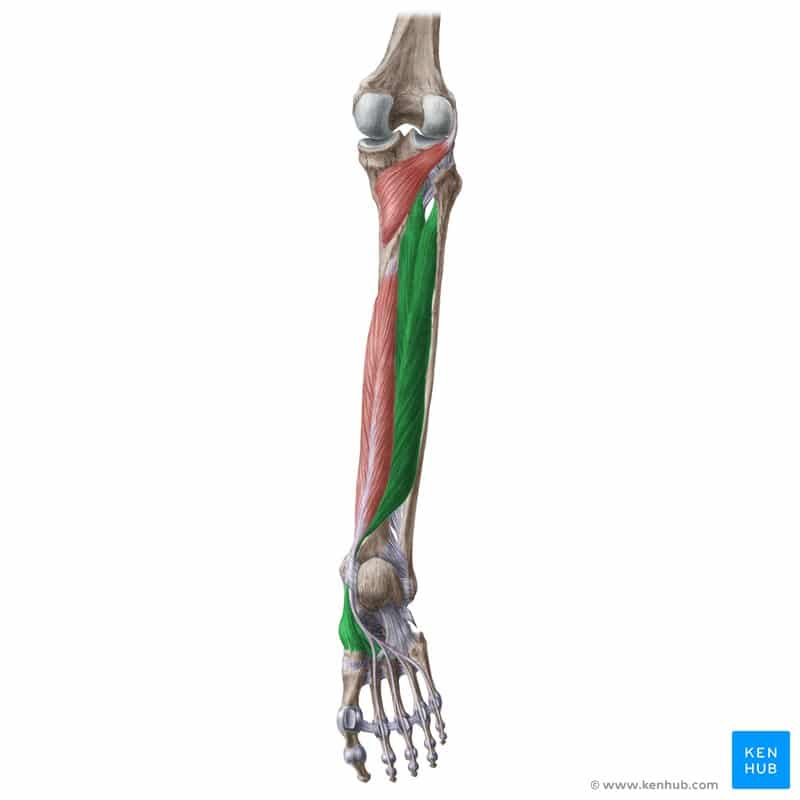
✅ Persian Name: Dorshtani Khalafi
✅ Latin Name: Tibialis Posterior
✅ Common Name: “Foot stabilizer muscle” or “balance muscle of the lower leg”
✅ Location:
🟡 The deepest muscle of the lower leg, located behind the tibia.
🟡 Part of the deep posterior compartment of the lower leg muscles.
🟡 Responsible for plantarflexion of the ankle and inversion of the foot.
✅ 🦾 Origin
✔ Posterior surface of the tibia and fibula
✔ Interosseous membrane of the leg
✅ 🦿 Insertion
✔ Navicular, cuneiform, and cuboid bones
✔ Second to fourth metatarsal bones
✅ 📌 Function
✔ Plantarflexion of the ankle – assists in vertical foot movements.
✔ Inversion of the foot – stabilizes the ankle during walking and running.
✔ Maintains and supports the foot arch – prevents flatfoot.
✅ 💪🏻 Muscle Fiber Type
✔ A combination of slow-twitch fibers (Type I) for high endurance and fast-twitch fibers (Type II) for quick response.
✅ 🏋🏻♂️ Role in Motor and Athletic Performance
✔ Active in sports such as running, walking, football, and basketball.
✔ Helps strengthen the foot arch and prevents recurrent ankle sprains.
✅ 🧗🏻♂️ Muscle Strength and Endurance
✔ The tibialis posterior muscle plays a fundamental role in maintaining balance during walking and running.
✔ Its weakness leads to impaired balance and reduced performance in endurance sports.
🧠 Innervation
✔ Tibial nerve (L4, L5)
🩸 Blood Supply
✔ Posterior tibial artery
✅ 🤼♂️ Role in Sports and Physical Activities
✔ Running and walking: helps maintain the foot arch and ankle stability.
✔ Sports such as basketball and football: helps prevent injuries caused by lateral movements.
✔ Yoga and Pilates: aids in maintaining balance when standing on one leg.
✅ 🏌🏻♂️ Relationship with Other Muscles and Joints
✔ Works with the toe flexors and fibularis muscles to control ankle movements.
✔ Collaborates with the foot arch muscles to stabilize the foot and prevent arch collapse.
✅ 💉 Vulnerability and Potential Issues
✔ Posterior tibial tendinitis – causes pain on the inner side of the ankle.
✔ Flat foot syndrome – leads to reduced ankle function and increased fatigue during walking.
✅ 🏋🏻♂️ Key Exercises to Strengthen the Tibialis Posterior
1️⃣ Weighted calf raises – increase muscle strength.
2️⃣ Inversion with resistance band – strengthens internal foot rotation.
3️⃣ Single-leg balance exercises – improve the stabilizing function of this muscle.
4️⃣ Arch strengthening drills – enhance foot arch support.
✅ 🧘🏻♀️ Stretching and Recovery
✔ Calf and ankle stretches – increase flexibility and reduce muscle tension.
✔ Massage of the foot sole and calf muscles – prevents cramps and improves blood circulation.
✅ 🔍 Interesting Fact
✔ This muscle is one of the primary stabilizers of the foot arch, and its weakness can lead to flat feet!
✅ 💡 Practical Tip
✔ Internal foot rotation exercises with a resistance band are among the best ways to strengthen this muscle.
🔴 Name and Location: A deep muscle of the lower leg extending from the tibia and fibula to the bones of the foot arch.
🟠 Anatomy: Originates from the bones of the lower leg, inserting into the bones of the foot and metatarsals.
🟡 Function: Plantarflexion of the ankle, foot inversion, and stabilization of the foot arch.
🟢 Physiology: Contains slow-twitch fibers for high endurance.
🔵 Innervation: Tibial nerve (L4, L5).
🟣 Importance: Active in walking, running, agility sports, and yoga.
🟤 Exercises: Calf raises, internal foot rotation exercises, and balance drills.
⚫ Interesting Note: Weakness in this muscle can lead to flat feet and chronic ankle pain.
Flexor Digitorum Longus Muscle
Flexor Digitorum Longus Muscle
The flexor digitorum longus muscle is one of the deep posterior muscles of the lower leg. Its primary role is flexing the second to fifth toes and assisting in plantarflexion of the ankle. This muscle plays a key role in gripping objects with the toes, walking, running, and maintaining the stability of the foot arch. Weakness in this muscle leads to reduced toe flexion strength, impaired balance, and increased pressure on the foot sole and ankle. Below, we provide a comprehensive review of this muscle according to the standard checklist. ✅
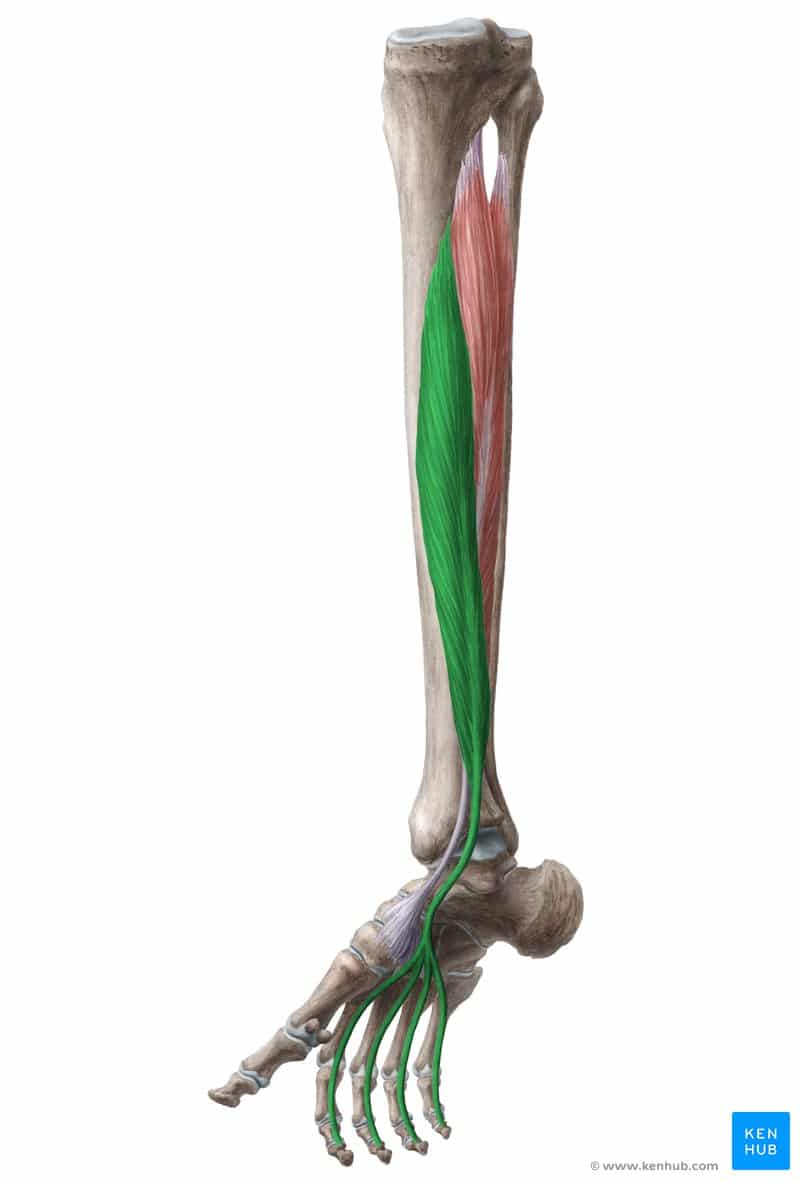
✅ Persian Name: Kham-konande Boland Angoshtan Pa
✅ Latin Name: Flexor Digitorum Longus (FDL)
✅ Common Name: “Flexor digitorum longus” or “toe flexor muscle”
✅ Location:
🟡 Located in the deep posterior part of the lower leg.
🟡 Part of the deep posterior compartment of the lower leg muscles.
🟡 Responsible for flexing the second to fifth toes and plantarflexion of the ankle.
✅ 🦾 Origin
✔ Posterior surface of the middle third of the tibia
✅ 🦿 Insertion
✔ Bases of the distal phalanges of toes 2 to 5
✅ 📌 Function
✔ Flexion of toes 2 to 5 – assists in gripping objects with the toes.
✔ Plantarflexion of the ankle – enhances stability during walking and running.
✔ Maintains balance and supports the foot arch.
✅ 💪🏻 Muscle Fiber Type
✔ A combination of slow-twitch fibers (Type I) for endurance and fast-twitch fibers (Type II) for rapid response.
✅ 🏋🏻♂️ Role in Motor and Athletic Functions
✔ Assists in walking, running, climbing stairs, and stretching movements.
✔ Plays a key role in sports such as running, gymnastics, yoga, and mountaineering.
✔ Active in grasping small objects with the toes (e.g., picking up a pencil).
✅ 🧗🏻♂️ Muscle Strength and Endurance
✔ This muscle plays a vital role in balance and control of foot movements.
✔ Its weakness leads to poor control of toe movements and rapid fatigue during prolonged activities.
🧠 Innervation
✔ Tibial Nerve (L5, S1, S2)
🩸 Blood Supply
✔ Posterior tibial artery
✅ 🤼♂️ Role in Sports and Physical Activities
✔ Running and Walking: Assists in proper foot flexion and shock absorption during stepping.
✔ Sports such as gymnastics and yoga: Strengthen the endurance of foot and ankle muscles.
✔ Stabilizing the foot arch during prolonged walking.
✅ 🏌🏻♂️ Interaction with Other Muscles and Joints
✔ Works with the flexor hallucis longus and the posterior tibialis muscles to control ankle movements.
✔ Cooperates with the foot muscles to provide stability during walking and running.
✅ 💉 Vulnerability and Potential Issues
✔ Flexor tendonitis – causing pain in the sole and toes.
✔ Weakness of this muscle increases pressure on the foot arch, leading to discomfort during prolonged standing.
✅ 🏋🏻♂️ Key Exercises to Strengthen the Flexor Digitorum Longus Muscle
1️⃣ Toe Grip Exercises – strengthening the muscle by using a towel or pencil.
2️⃣ Toe Walking – enhancing the strength of the foot muscles.
3️⃣ Toe Flexion with Resistance Band – increasing toe flexion power.
4️⃣ Single-Leg Balance Exercises – improving the stabilizing function of this muscle.
✅ 🧘🏻♀️ Stretching and Recovery Movements
✔ Stretching the sole and ankle – reducing strain and improving muscle flexibility.
✔ Massaging the sole and toes – enhancing blood circulation and preventing cramps.
✅ 🔍 Interesting Fact
✔ This muscle is continuously active during walking, running, and even prolonged standing—often without us noticing!
✅ 💡 Practical Tip
✔ If you feel pain in the sole and toes after long walks or running, this muscle is likely fatigued or inflamed!
🔴 Name and Location:
A deep calf muscle extending from the tibia to the distal ends of toes two through five.
🟠 Anatomy: Originates from the posterior surface of the tibia, inserting into the distal phalanges of toes two through five.
🟡 Function: Flexion of the toes, assists in ankle plantarflexion, and stabilizes the foot arch.
🟢 Physiology: contains both slow- and fast-twitch fibers that support endurance and precise control of foot movements.
🔵 Innervation: Tibial nerve (L5, S1, S2).
🟣 Importance: Active during walking, running, yoga, gymnastics, and mountaineering.
🟤 Exercises: Toe gripping exercises, toe walking drills, and balance training.
⚫ Interesting Facts: This muscle is engaged even while standing!
Flexor Hallucis Longus Muscle
Flexor Hallucis Longus - FHL Muscle
The flexor hallucis longus muscle is one of the most important deep posterior calf muscles, primarily responsible for flexing the big toe and assisting in plantarflexion of the ankle. This muscle plays a crucial role in running, jumping, and maintaining balance when standing on one foot. Weakness in this muscle can lead to reduced power in pushing off the ground with the big toe, impaired running balance, and an increased risk of ankle and foot injuries. Below is a comprehensive review of this muscle according to the standard checklist. ✅
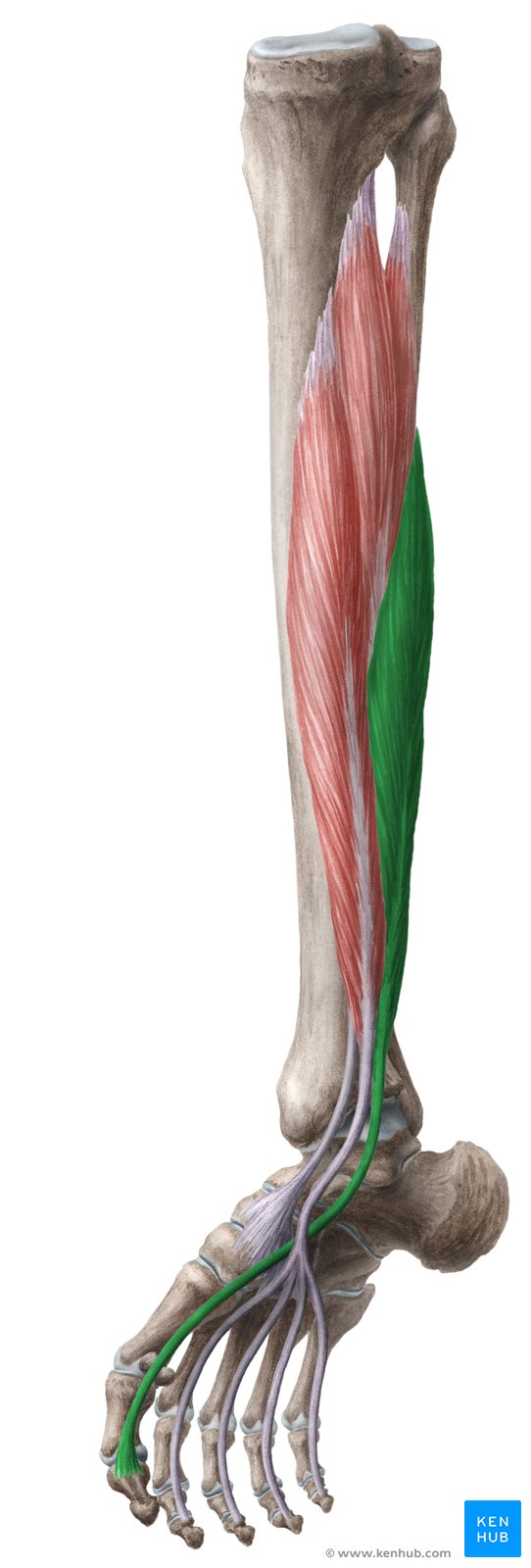
✅ Persian Name: Kham-konande Boland Shast Pa
✅ Latin Name: Flexor Hallucis Longus (FHL)
✅ Common Names: “Flexor Pollicis Longus” or “Big Toe Flexor”
✅ Location:
🟡 Located in the deep posterior part of the calf, on the lateral side.
🟡 Part of the deep posterior compartment muscles of the calf.
🟡 Responsible for flexing the big toe and assisting in plantarflexion of the ankle.
✅ 🦾 Origin
✔ Posterior surface of the fibula (lower two-thirds)
✔ Interosseous membrane of the leg
✅ 🦿 Insertion
✔ Base of the distal phalanx of the great toe (hallux)
✅ 📌 Function
✔ Flexion of the hallux (big toe) – crucial for explosive foot movements.
✔ Assists in plantarflexion of the ankle – enhances power during walking and running.
✔ Maintains balance and generates propulsion force during running and jumping.
✅ 💪🏻 Muscle Fiber Type
✔ A combination of slow-twitch fibers (Type I) for endurance and fast-twitch fibers (Type II) for rapid response.
✅ 🏋🏻♂️ Role in Motor and Athletic Functions
✔ Assists in running, jumping, and explosive movements requiring pressure on the big toe.
✔ Plays a key role in sports such as football, basketball, gymnastics, and sprinting.
✔ Active in fine toe movements, such as ball control in football.
✅ 🧗🏻♂️ Muscle Strength and Endurance
✔ This muscle is crucial for power movements such as sprinting and hurdle jumping.
✔ Its weakness leads to decreased jumping ability, reduced balance, and increased strain on other ankle muscles.
🧠 Innervation
✔ Tibial Nerve (L5, S1, S2)
🩸 Blood Supply
✔ Posterior tibial artery
✅ 🤼♂️ Role in Sports and Physical Activities
✔ Running and jumping: enhances the propulsion power of the foot during takeoff.
✔ Gymnastics and basketball: provides balance on the toes and controls big toe movements.
✔ Fine toe movements in technical sports such as football.
✅ 🏌🏻♂️ Interaction with Other Muscles and Joints
✔ Works with the toe flexors and the posterior tibialis muscle to control foot movements.
✔ Collaborates with the gastrocnemius and soleus muscles to generate plantarflexion force at the ankle.
✅ 💉 Vulnerability and Potential Issues
✔ Flexor Hallucis Longus Tendinitis – causing pain and inflammation in the ankle and sole of the foot.
✔ Weakness of this muscle leads to reduced jumping ability, impaired running balance, and increased strain on other foot muscles.
✅ 🏋🏻♂️ Key Exercises to Strengthen the Flexor Hallucis Longus Muscle
1️⃣ Big Toe Flexion with Resistance Band – enhances the flexion strength of the big toe.
2️⃣ Toe Walking – increases the strength of the foot muscles.
3️⃣ Toe Press Against a Ball – improves muscle strength and control.
4️⃣ Heel Raise with Toe Press – strengthens the muscle in functional movements.
✅ 🧘🏻♀️ Stretching and Recovery Movements
✔ Stretching the sole and ankle – reduces strain and improves muscle flexibility.
✔ Massaging the sole and big toe – prevents cramps and increases blood circulation.
✅ 🔍 Interesting Fact
✔ This muscle plays a vital role in maintaining balance when standing on one foot!
✅ 💡 Practical Tip
✔ Strengthening this muscle improves vertical jumping and enhances control during sprinting.
🔴 Name and Location:
A deep calf muscle extending from the fibula to the distal end of the big toe.
🟠 Anatomy: Originates from the posterior surface of the fibula, inserting into the distal phalanx of the big toe.
🟡 Function: Flexion of the big toe, assists in ankle plantarflexion, and stabilizes balance during jumping.
🟢 Physiology: Composed of both slow-twitch and fast-twitch muscle fibers to support endurance and powerful movements.
🔵 Innervation: Tibial nerve (L5, S1, S2).
🟣 Importance: Active in running, jumping, football, gymnastics, and basketball.
🟤 Exercises: Big toe flexion with resistance band, toe walking, pressing a ball under the big toe.
⚫ Interesting Facts: This muscle is essential for maintaining balance when standing on one foot!
Popliteus Muscle
Popliteus Muscle
📌 The popliteus muscle is one of the deep muscles located at the back of the knee, playing a key role in knee stabilization and movement. Known as the “key to unlocking the knee,” it activates at the start of knee flexion by slightly rotating the tibia inward to unlock the knee joint.
💡 Unlike other calf muscles that primarily act on the ankle and toes, the popliteus directly influences the knee joint and controls the initial movements of the knee. This muscle is not only important for initiating knee movement but also helps prevent overstretching of the knee ligaments and reduces stress on the joint.
🔹 Why is this muscle important?
✔ Without proper popliteus function, the knee locks in full extension, making flexion difficult.
✔ During twisting movements and sudden changes in direction (e.g., football and basketball), it helps prevent knee injuries.
✔ Provides support in stabilizing the knee joint during prolonged standing and helps reduce stress on the anterior cruciate ligament (ACL).
📌 Although the popliteus is a small muscle, it is crucial for proper knee function and ligament injury prevention. Weakness or inflammation of this muscle can cause pain behind the knee and reduce joint stability. Below is a detailed review of this muscle’s anatomy, function, role in sports, and strengthening exercises. ✅

✅ Persian Name: Popliteus
✅ Latin Name: Popliteus
✅ Common Names: “Muscle behind the knee” or “Knee movement starter muscle”
✅ Location:
🟡 Located at the back of the knee (popliteal fossa), between the femur and tibia.
🟡 Part of the deep posterior compartment muscles of the calf.
🟡 Its role is tibial rotation and knee stabilization.
✅ 🦾 Origin
✔ Lateral condyle of the femur
✔ Joint capsule of the knee
✅ 🦿 Insertion
✔ Posterior surface of the tibia (above the soleal line)
✅ 📌 Function
✔ Medial rotation of the tibia during walking and sudden changes in direction.
✔ Initiates knee flexion by unlocking the knee joint.
✔ Stabilizes the knee joint and prevents overstretching of ligaments.
✅ 💪🏻 Muscle Fiber Type
✔ Contains slow-twitch fibers (Type I) for endurance and stable knee control.
✅ 🏋🏻♂️ Role in Motor and Athletic Functions
✔ Active in initiating knee movement during standing, running, and changing direction.
✔ Involved in stabilizing the knee during landing after a jump.
✅ 🧗🏻♂️ Muscle Strength and Endurance
✔ A small but vital muscle for knee stability and reducing strain on other muscles.
🧠 Innervation
✔ Tibial nerve (L4, L5, S1)
🩸 Blood Supply
✔ Posterior tibial artery
✅ 🤼♂️ Role in Sports and Physical Activities
✔ Running and sudden changes in direction: stabilizes the knee and reduces injury risk.
✔ Squats and lunges: assists in stabilizing the knee during lower-body movements.
✅ 🏌🏻♂️ Interaction with Other Muscles and Joints
✔ Works with the hamstrings and quadriceps to control knee movements.
✅ 💉 Vulnerability and Potential Issues
✔ Posterior knee pain (Popliteus Syndrome) – caused by overuse or muscle weakness.
✔ Knee joint inflammation resulting from muscle weakness.
✅ 🏋🏻♂️ Key Exercises to Strengthen the Popliteus Muscle
1️⃣ Medial rotation knee exercise – improves knee control.
2️⃣ Single-leg balance drills – enhances knee stability.
3️⃣ Partial squats – activates the muscle during knee flexion.
4️⃣ Agility drills involving sudden starts and stops – strengthens popliteus performance in speed sports.
✅ 🧘🏻♀️ Stretching and Recovery Movements
✔ Stretching the muscles behind the knee – improves flexibility and reduces strain.
✔ Massaging the back of the knee – relieves fatigue and enhances blood circulation.
✅ 🔍 Interesting Fact
✔ This small but vital muscle is essential for “unlocking” the knee before any movement!
✅ 💡 Practical Tip
✔ Athletes with weak knees should strengthen this muscle to prevent ligament injuries.
🔴 Name and Location:
A muscle at the back of the knee that plays a key role in knee stabilization.
🟠 Anatomy:
Originates from the lateral condyle of the femur, inserts into the posterior surface of the tibia.
🟡 Function:
Initiates knee flexion, medially rotates the tibia, stabilizes the knee joint.
🟢 Physiology:
Contains slow-twitch fibers for endurance and knee movement control.
🔵 Innervation:
Tibial nerve (L4, L5, S1).
🟣 Importance:
Active in running, squatting, jumping, and agility sports.
🟤 Exercises:
Knee medial rotation, single-leg balance, partial squats.
⚫ Interesting Facts:
This is the first muscle activated to start knee movement!
Interesting and Practical Facts
1. The strongest muscle for explosive jumps! 🏀
📌 The gastrocnemius muscle (calf muscle) is one of the primary muscles responsible for generating explosive power in vertical jumps. It is highly active in all sports requiring jumping, such as basketball, volleyball, and gymnastics.
2. The soleus: the endurance champion! 🏃♂️
📌 The soleus muscle, with the highest proportion of slow-twitch (Type I) fibers, is the endurance champion among muscles in the body. It remains active even during prolonged standing, and without it, the body would lack sufficient balance!
3. The Knee Unlocker 🔓
📌 The popliteus muscle is the first muscle activated during knee flexion. Without this muscle, the knee locks in an extended position, making bending difficult!
4. Why do your arches collapse? 🤔
📌 Weakness of the tibialis posterior muscle is one of the main causes of flat foot. If this muscle is weak, your foot arch becomes flatter than normal, placing increased stress on the ankle.
5. The Big Toe, the Key to Balance! 🔑
📌 The flexor hallucis longus muscle (FHL) is one of the most vital muscles for maintaining balance when standing on one foot. Approximately 70% of the propulsive force required for running or jumping is transmitted through the big toe! 😲
6. Is life difficult without the plantaris? 🤷♂️
📌 The plantaris muscle is absent in 10 to 40 percent of people! Its absence has no effect on movement function, but in those who have it, the tendon is sometimes used to repair Achilles tendon injuries!
7. You can’t gain speed without the gastrocnemius! 🚀
📌 Sprinting is nearly impossible without the gastrocnemius muscle. This muscle is responsible for generating the force needed to accelerate during running, and sprinters develop it extensively!
8. The surprising role of the soleus muscle in blood pressure regulation 🩸
📌 The soleus muscle is known as the "second heart pump" because it assists blood return from the legs to the heart. Weakness in this muscle can lead to leg swelling and circulatory problems!
10. Why do some people have big calves? 🤯
📌 Calf size is more related to genetics than training. Some people naturally have shorter Achilles tendons and larger muscle shapes, making their calves appear bulkier!
11. Stronger ankles = fewer injuries! ⚡
📌 Individuals with a weak tibialis anterior muscle are more prone to ankle injuries, such as recurrent sprains. Strengthening this muscle is key to reducing common ankle injuries!
12. Can you walk without calf muscles? 🚶♂️
📌 If all calf muscles become inactive, walking is still possible! However, it will be without proper control and balance, as the hip and knee joints try to compensate for the deficiency.
13. Sudden calf cramps! 😖
📌 Over 80% of nighttime calf cramps are due to magnesium and potassium deficiencies. Runners and endurance athletes are more prone to this type of cramping.
14. Can you really bulk up your calf muscles? 🏋️♂️
📌 The calf is one of the toughest muscles to grow because it endures heavy loads daily. To increase calf size, heavy training with a full range of motion is necessary.
15. Why is calf pain worse after running? 🏃♂️
📌 Medial tibial stress syndrome (shin splints) typically occurs due to overuse of the tibialis anterior muscle. This issue is common among runners and athletes who have recently intensified their training.
16. Why do some people have asymmetrical calves? 🤷♀️
📌 Asymmetry in calf size can result from differences in muscle activity or neural factors. Athletes who favor one side of the body (such as tennis players) usually have a stronger calf on that side.
17. Calf muscles recover faster than other muscles! ⏳
📌 Calf muscles recover faster than other muscles due to their high density of slow-twitch (Type I) fibers. This is why they can be trained more frequently throughout the week.
18. Do strong calves help with more powerful throws? 🎯
📌 Yes! The calf muscles play a key role in transferring power from the ground through the body. In sports like baseball and boxing, strong calves increase the force of throws and strikes.
19. Achilles tendon = the strongest tendon in the body! 💪
📌 The Achilles tendon, which connects the gastrocnemius and soleus muscles to the heel, is the strongest and largest tendon in the body. It can withstand forces over 10 times the body’s weight!
20. Why do some runners have slimmer calves? 🏃♂️
📌 Endurance runners (such as marathoners) typically have slimmer calves because less muscle mass means greater energy efficiency during long runs. In contrast, sprinters have bulkier calves essential for generating explosive power!
Conclusion
Conclusion
📌 The calf muscles are among the most vital muscle groups in the body, playing an undeniable role in every daily movement—from walking and running to jumping and balancing. These muscles are categorized into three main groups (anterior, lateral, and posterior), each performing distinct but complementary functions.
💡 Key takeaways from this review:
✔ The gastrocnemius plays a crucial role in explosive power and speed movements.
✔ The soleus is the endurance champion, providing long-term stability.
✔ The popliteus is essential for unlocking and stabilizing the knee.
✔ The toe and big toe flexors are vital for grasping objects and maintaining balance.
✔ The tibialis posterior is key to forming and supporting the foot arch, preventing flat feet.
✔ The tibialis anterior prevents sudden foot drop during walking.
📌 Neglecting these muscles can lead to issues such as flat feet, ankle and knee pain, reduced running endurance, and a higher risk of sports injuries. Therefore, strengthening these muscles is essential not only for athletes but for everyone.
🔥 The bottom line? The calf isn’t just a simple part of the body—it’s one of the most complex and vital movement structures that must be properly strengthened, stretched, and cared for. 🚀💪
✅ If you care about peak performance and injury prevention, never underestimate calf training! 😉🔥
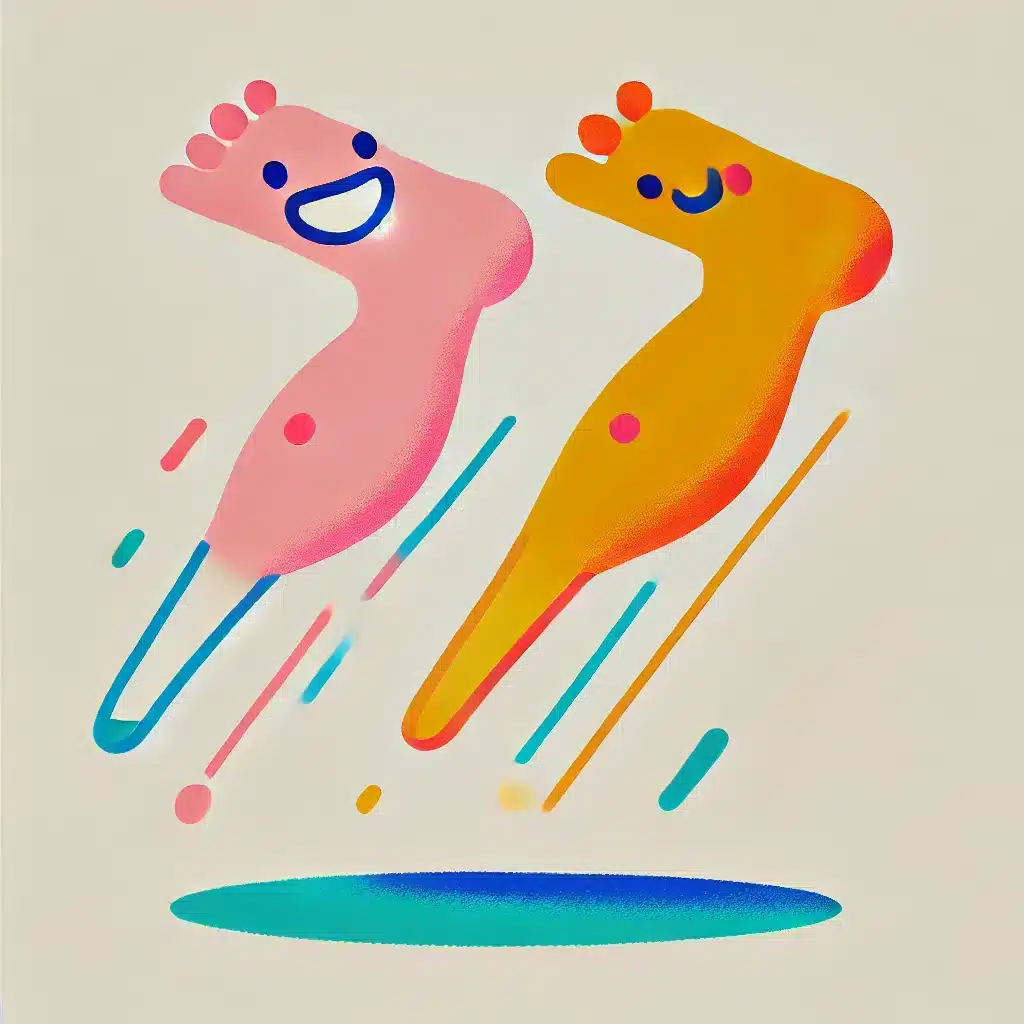
References
Resources
Anatomy and medical books :
Gray's Anatomy (one of the standard references in anatomy)
Netter's Atlas of Human Anatomy (a well-known illustrated atlas in anatomy)
Clinically Oriented Anatomy by Keith Moore
Medical databases :
PubMed (for scientific and research articles)
MedlinePlus (health and medical information)
WebMD (for practical and general health information)
Sports and training references :
Strength Training Anatomy by Frederic Delavier
Essentials of Strength Training and Conditioning by NSCA
Well-known articles and training programs by international coaches
Medical databases :
PubMed (for scientific and research articles)
MedlinePlus (health and medical information)
WebMD (for practical and general health information)
Specialized sports and health websites :
Images used:
(Kenhub) kenhub.com
Further Reading
Further reading
Pelank Life | Body Health Assessment
The Best Body Health Calculators Using Scientific Methods
Developed by Pelank Life ©